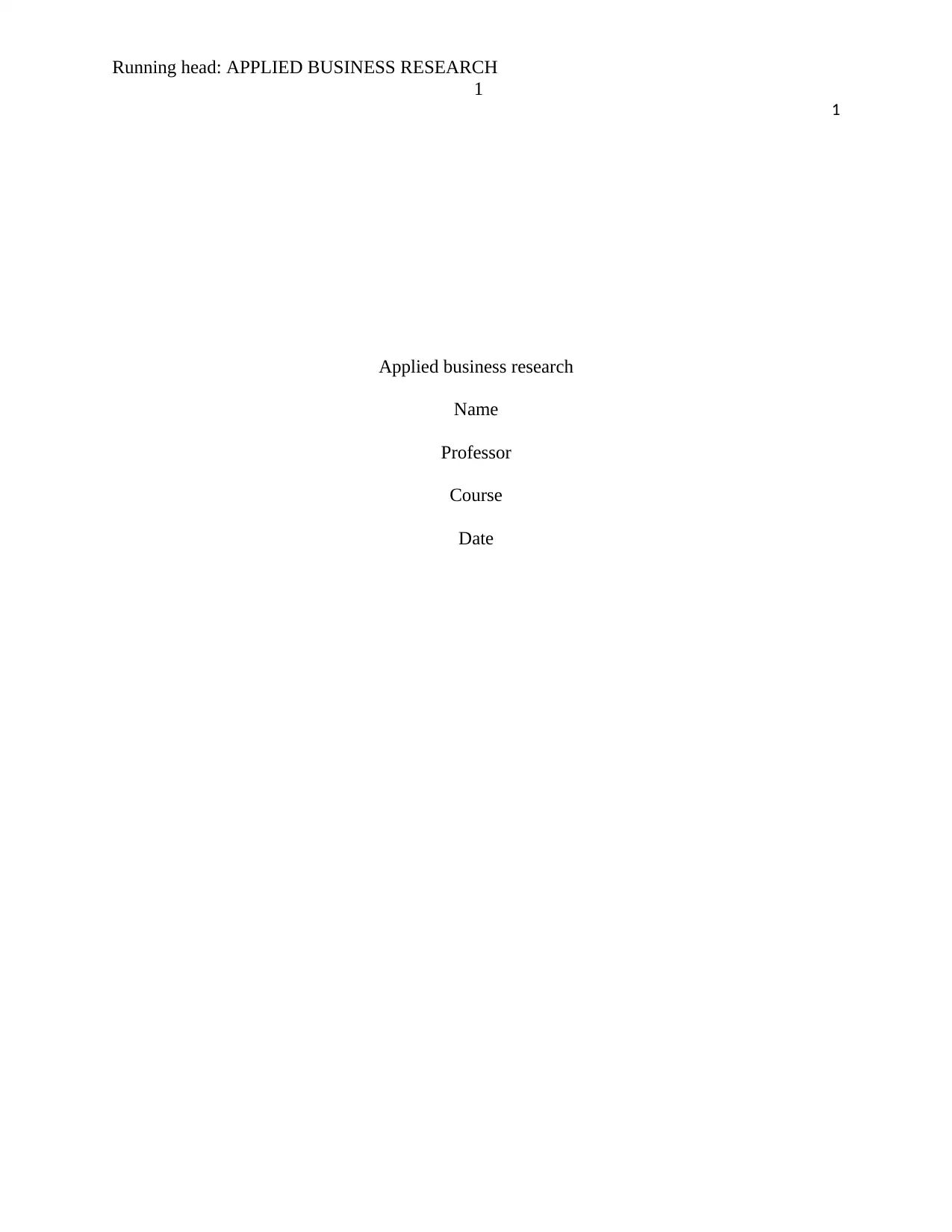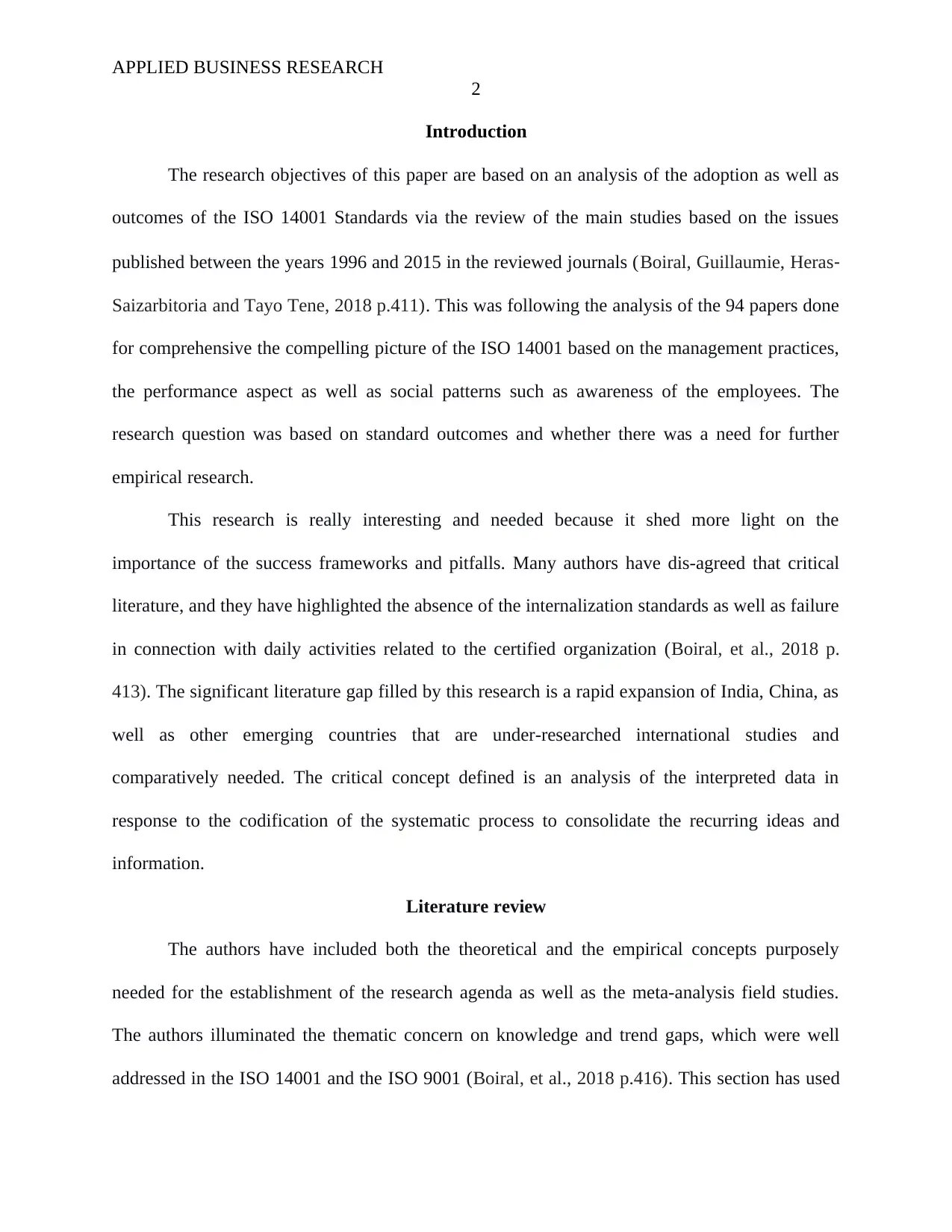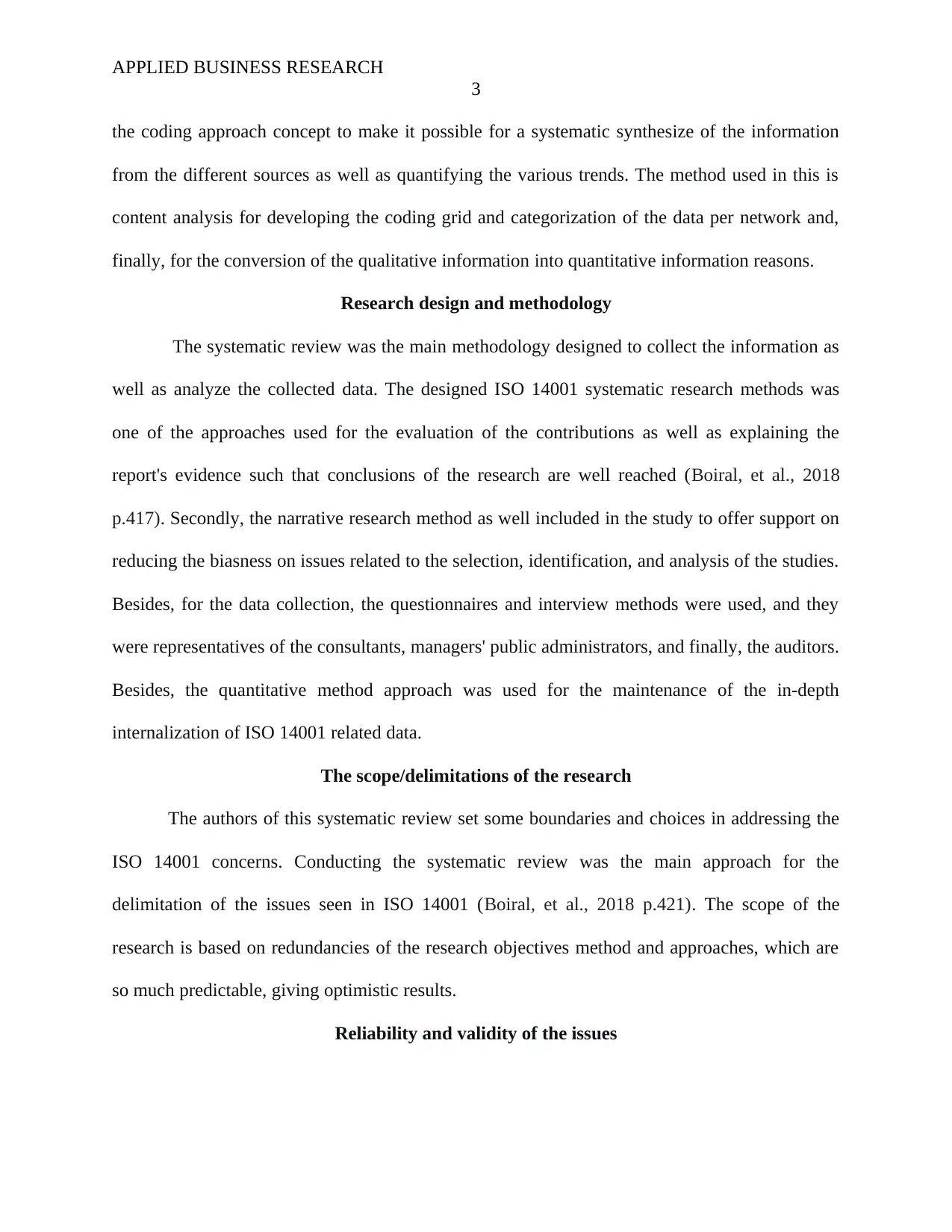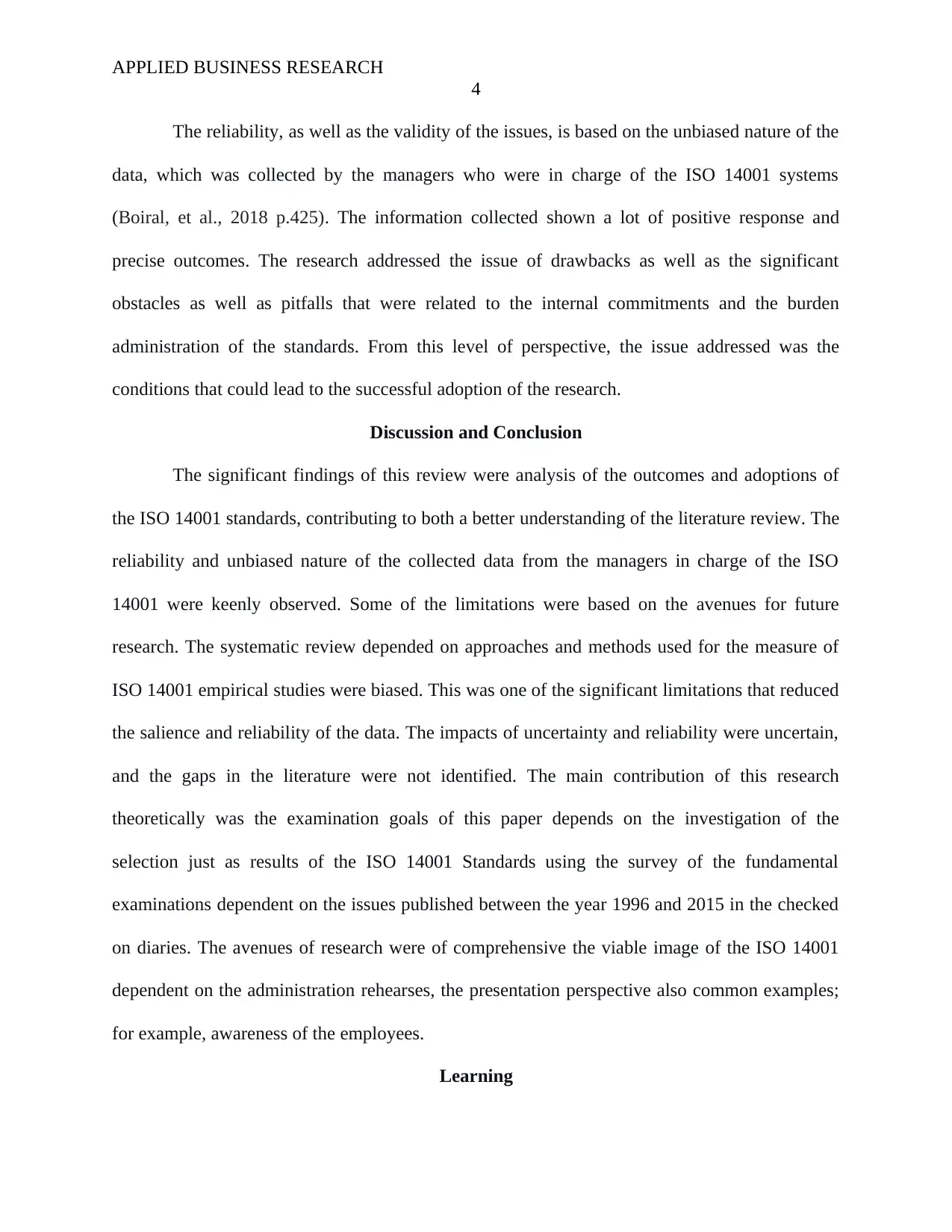Applied Business Research: ISO 14001 Standards Adoption Outcomes
VerifiedAdded on 2022/08/12
|6
|1205
|24
Report
AI Summary
This report presents an analysis of the adoption and outcomes of ISO 14001 standards, based on a systematic review of research published between 1996 and 2015. The research examines the effectiveness of ISO 14001 in management practices and social patterns, using methods such as content analysis and narrative research. The study addresses research objectives, literature gaps, and key concepts. The methodology includes a systematic review and data collection through questionnaires and interviews. The report discusses the reliability and validity of the findings, including limitations such as the bias in empirical studies and the lack of identified gaps in the literature. The research contributes to a better understanding of the adoption of ISO 14001 standards and the conditions for successful implementation, identifying key success factors and relevant components. The findings are based on quantitative analysis dependent on the impression of directors from North American and European nations speaking to a generally little part of ISO 14001 accreditations around the world.

Running head: APPLIED BUSINESS RESEARCH
1
1
Applied business research
Name
Professor
Course
Date
1
1
Applied business research
Name
Professor
Course
Date
Paraphrase This Document
Need a fresh take? Get an instant paraphrase of this document with our AI Paraphraser

APPLIED BUSINESS RESEARCH
2
Introduction
The research objectives of this paper are based on an analysis of the adoption as well as
outcomes of the ISO 14001 Standards via the review of the main studies based on the issues
published between the years 1996 and 2015 in the reviewed journals (Boiral, Guillaumie, Heras‐
Saizarbitoria and Tayo Tene, 2018 p.411). This was following the analysis of the 94 papers done
for comprehensive the compelling picture of the ISO 14001 based on the management practices,
the performance aspect as well as social patterns such as awareness of the employees. The
research question was based on standard outcomes and whether there was a need for further
empirical research.
This research is really interesting and needed because it shed more light on the
importance of the success frameworks and pitfalls. Many authors have dis-agreed that critical
literature, and they have highlighted the absence of the internalization standards as well as failure
in connection with daily activities related to the certified organization (Boiral, et al., 2018 p.
413). The significant literature gap filled by this research is a rapid expansion of India, China, as
well as other emerging countries that are under-researched international studies and
comparatively needed. The critical concept defined is an analysis of the interpreted data in
response to the codification of the systematic process to consolidate the recurring ideas and
information.
Literature review
The authors have included both the theoretical and the empirical concepts purposely
needed for the establishment of the research agenda as well as the meta-analysis field studies.
The authors illuminated the thematic concern on knowledge and trend gaps, which were well
addressed in the ISO 14001 and the ISO 9001 (Boiral, et al., 2018 p.416). This section has used
2
Introduction
The research objectives of this paper are based on an analysis of the adoption as well as
outcomes of the ISO 14001 Standards via the review of the main studies based on the issues
published between the years 1996 and 2015 in the reviewed journals (Boiral, Guillaumie, Heras‐
Saizarbitoria and Tayo Tene, 2018 p.411). This was following the analysis of the 94 papers done
for comprehensive the compelling picture of the ISO 14001 based on the management practices,
the performance aspect as well as social patterns such as awareness of the employees. The
research question was based on standard outcomes and whether there was a need for further
empirical research.
This research is really interesting and needed because it shed more light on the
importance of the success frameworks and pitfalls. Many authors have dis-agreed that critical
literature, and they have highlighted the absence of the internalization standards as well as failure
in connection with daily activities related to the certified organization (Boiral, et al., 2018 p.
413). The significant literature gap filled by this research is a rapid expansion of India, China, as
well as other emerging countries that are under-researched international studies and
comparatively needed. The critical concept defined is an analysis of the interpreted data in
response to the codification of the systematic process to consolidate the recurring ideas and
information.
Literature review
The authors have included both the theoretical and the empirical concepts purposely
needed for the establishment of the research agenda as well as the meta-analysis field studies.
The authors illuminated the thematic concern on knowledge and trend gaps, which were well
addressed in the ISO 14001 and the ISO 9001 (Boiral, et al., 2018 p.416). This section has used

APPLIED BUSINESS RESEARCH
3
the coding approach concept to make it possible for a systematic synthesize of the information
from the different sources as well as quantifying the various trends. The method used in this is
content analysis for developing the coding grid and categorization of the data per network and,
finally, for the conversion of the qualitative information into quantitative information reasons.
Research design and methodology
The systematic review was the main methodology designed to collect the information as
well as analyze the collected data. The designed ISO 14001 systematic research methods was
one of the approaches used for the evaluation of the contributions as well as explaining the
report's evidence such that conclusions of the research are well reached (Boiral, et al., 2018
p.417). Secondly, the narrative research method as well included in the study to offer support on
reducing the biasness on issues related to the selection, identification, and analysis of the studies.
Besides, for the data collection, the questionnaires and interview methods were used, and they
were representatives of the consultants, managers' public administrators, and finally, the auditors.
Besides, the quantitative method approach was used for the maintenance of the in-depth
internalization of ISO 14001 related data.
The scope/delimitations of the research
The authors of this systematic review set some boundaries and choices in addressing the
ISO 14001 concerns. Conducting the systematic review was the main approach for the
delimitation of the issues seen in ISO 14001 (Boiral, et al., 2018 p.421). The scope of the
research is based on redundancies of the research objectives method and approaches, which are
so much predictable, giving optimistic results.
Reliability and validity of the issues
3
the coding approach concept to make it possible for a systematic synthesize of the information
from the different sources as well as quantifying the various trends. The method used in this is
content analysis for developing the coding grid and categorization of the data per network and,
finally, for the conversion of the qualitative information into quantitative information reasons.
Research design and methodology
The systematic review was the main methodology designed to collect the information as
well as analyze the collected data. The designed ISO 14001 systematic research methods was
one of the approaches used for the evaluation of the contributions as well as explaining the
report's evidence such that conclusions of the research are well reached (Boiral, et al., 2018
p.417). Secondly, the narrative research method as well included in the study to offer support on
reducing the biasness on issues related to the selection, identification, and analysis of the studies.
Besides, for the data collection, the questionnaires and interview methods were used, and they
were representatives of the consultants, managers' public administrators, and finally, the auditors.
Besides, the quantitative method approach was used for the maintenance of the in-depth
internalization of ISO 14001 related data.
The scope/delimitations of the research
The authors of this systematic review set some boundaries and choices in addressing the
ISO 14001 concerns. Conducting the systematic review was the main approach for the
delimitation of the issues seen in ISO 14001 (Boiral, et al., 2018 p.421). The scope of the
research is based on redundancies of the research objectives method and approaches, which are
so much predictable, giving optimistic results.
Reliability and validity of the issues
⊘ This is a preview!⊘
Do you want full access?
Subscribe today to unlock all pages.

Trusted by 1+ million students worldwide

APPLIED BUSINESS RESEARCH
4
The reliability, as well as the validity of the issues, is based on the unbiased nature of the
data, which was collected by the managers who were in charge of the ISO 14001 systems
(Boiral, et al., 2018 p.425). The information collected shown a lot of positive response and
precise outcomes. The research addressed the issue of drawbacks as well as the significant
obstacles as well as pitfalls that were related to the internal commitments and the burden
administration of the standards. From this level of perspective, the issue addressed was the
conditions that could lead to the successful adoption of the research.
Discussion and Conclusion
The significant findings of this review were analysis of the outcomes and adoptions of
the ISO 14001 standards, contributing to both a better understanding of the literature review. The
reliability and unbiased nature of the collected data from the managers in charge of the ISO
14001 were keenly observed. Some of the limitations were based on the avenues for future
research. The systematic review depended on approaches and methods used for the measure of
ISO 14001 empirical studies were biased. This was one of the significant limitations that reduced
the salience and reliability of the data. The impacts of uncertainty and reliability were uncertain,
and the gaps in the literature were not identified. The main contribution of this research
theoretically was the examination goals of this paper depends on the investigation of the
selection just as results of the ISO 14001 Standards using the survey of the fundamental
examinations dependent on the issues published between the year 1996 and 2015 in the checked
on diaries. The avenues of research were of comprehensive the viable image of the ISO 14001
dependent on the administration rehearses, the presentation perspective also common examples;
for example, awareness of the employees.
Learning
4
The reliability, as well as the validity of the issues, is based on the unbiased nature of the
data, which was collected by the managers who were in charge of the ISO 14001 systems
(Boiral, et al., 2018 p.425). The information collected shown a lot of positive response and
precise outcomes. The research addressed the issue of drawbacks as well as the significant
obstacles as well as pitfalls that were related to the internal commitments and the burden
administration of the standards. From this level of perspective, the issue addressed was the
conditions that could lead to the successful adoption of the research.
Discussion and Conclusion
The significant findings of this review were analysis of the outcomes and adoptions of
the ISO 14001 standards, contributing to both a better understanding of the literature review. The
reliability and unbiased nature of the collected data from the managers in charge of the ISO
14001 were keenly observed. Some of the limitations were based on the avenues for future
research. The systematic review depended on approaches and methods used for the measure of
ISO 14001 empirical studies were biased. This was one of the significant limitations that reduced
the salience and reliability of the data. The impacts of uncertainty and reliability were uncertain,
and the gaps in the literature were not identified. The main contribution of this research
theoretically was the examination goals of this paper depends on the investigation of the
selection just as results of the ISO 14001 Standards using the survey of the fundamental
examinations dependent on the issues published between the year 1996 and 2015 in the checked
on diaries. The avenues of research were of comprehensive the viable image of the ISO 14001
dependent on the administration rehearses, the presentation perspective also common examples;
for example, awareness of the employees.
Learning
Paraphrase This Document
Need a fresh take? Get an instant paraphrase of this document with our AI Paraphraser

APPLIED BUSINESS RESEARCH
5
What was learned in this research is that a systematic survey reveals insight into the
fundamental discoveries and highlights of the research, which remains centered around
quantitative analysis dependent on the impression of directors from North American and
European nations speaking to a generally little part of ISO 14001 accreditations around the
world. I have learned that unbiased quality and fair-minded nature of the data gathered from
administrators accountable for the ISO 14001 framework were, in general, be taken for granted.
Although the results were commonly real, basic issues, for example, the job of experts,
reviewers, and different partners and representatives' recognitions, are disregarded. Besides, I
have seen that the standards were regularly ignored or conditioned somewhere near the select
spotlight on adequacy criteria. From this point of view, the principal question isn't whether the
measure is successful, but instead, what actions are taken into the record to quantify its effects
and what are the conditions for its fruitful selection. The research has recognized a few
achievement factors and relevant parts of the ISO 14001.
5
What was learned in this research is that a systematic survey reveals insight into the
fundamental discoveries and highlights of the research, which remains centered around
quantitative analysis dependent on the impression of directors from North American and
European nations speaking to a generally little part of ISO 14001 accreditations around the
world. I have learned that unbiased quality and fair-minded nature of the data gathered from
administrators accountable for the ISO 14001 framework were, in general, be taken for granted.
Although the results were commonly real, basic issues, for example, the job of experts,
reviewers, and different partners and representatives' recognitions, are disregarded. Besides, I
have seen that the standards were regularly ignored or conditioned somewhere near the select
spotlight on adequacy criteria. From this point of view, the principal question isn't whether the
measure is successful, but instead, what actions are taken into the record to quantify its effects
and what are the conditions for its fruitful selection. The research has recognized a few
achievement factors and relevant parts of the ISO 14001.

APPLIED BUSINESS RESEARCH
6
Rerefence
Boiral, O., Guillaumie, L., Heras‐Saizarbitoria, I. and Tayo Tene, C.V., 2018. Adoption and
outcomes of ISO 14001: a systematic review. International Journal of Management
Reviews, 20(2), pp.411-432.
6
Rerefence
Boiral, O., Guillaumie, L., Heras‐Saizarbitoria, I. and Tayo Tene, C.V., 2018. Adoption and
outcomes of ISO 14001: a systematic review. International Journal of Management
Reviews, 20(2), pp.411-432.
⊘ This is a preview!⊘
Do you want full access?
Subscribe today to unlock all pages.

Trusted by 1+ million students worldwide
1 out of 6
Related Documents
Your All-in-One AI-Powered Toolkit for Academic Success.
+13062052269
info@desklib.com
Available 24*7 on WhatsApp / Email
![[object Object]](/_next/static/media/star-bottom.7253800d.svg)
Unlock your academic potential
Copyright © 2020–2026 A2Z Services. All Rights Reserved. Developed and managed by ZUCOL.





